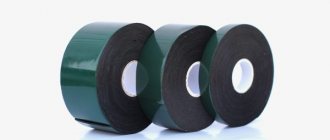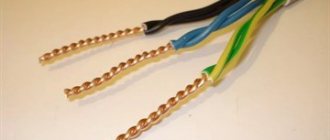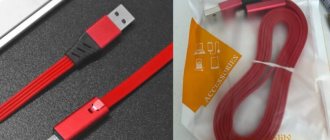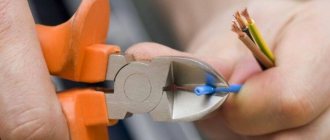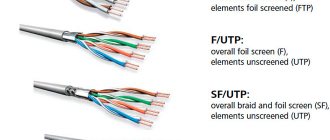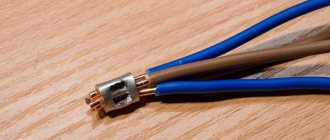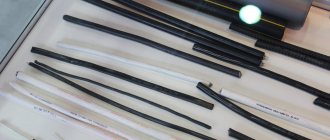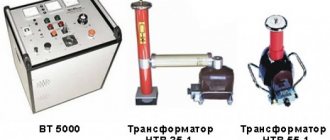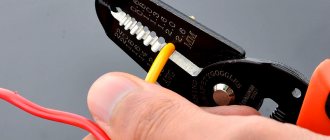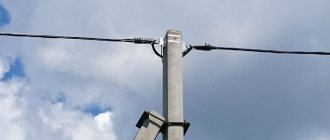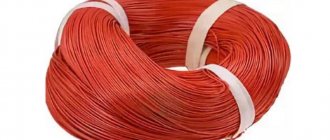Removing fluoroplastic insulation
This is a type of polymer coating that has good stable characteristics. The insulation coating is ideal, but quite expensive. It is customary to use it only for design calculations. This coating looks like a thin narrow tape tightly wrapped around a copper conductive wire. Only physical impact is suitable for removal. It is best to remove it using a sharp knife by scraping the surface layer to the required working length. Having exposed one edge, the wire is carefully bent to the side and the remaining insulating piece is cut off.
How to strip a wire while maintaining its properties
Let's start with simple methods.
Knife
A universal tool is used: a regular pen or office tool.
Improving the use of knives, many electricians make homemade devices for stripping insulation. For example, you can use a safety razor blade by simply screwing it to a clothespin.
Using holes of different diameters (on a clothespin), you get a universal tool for removing both the outer sheath and the coating directly on the conductors.
The simplest factory-made insulation stripping pliers work on this principle. The outer sheath is removed using calibrated holes, and conductors of small diameter are stripped using a blade with a molded hole.
Thermal method
If the question arises: how to quickly remove insulation from a wire, all means are good. Many craftsmen simply burn the ends of the conductors with a lighter or match. The method is not the best: Firstly, the cable may catch fire. Secondly, the remaining part of the shell loses its properties at a distance of 1–2 cm from the cleaned area. And finally, the conductor itself (copper or aluminum) is destroyed by such thermal effects.
If you need to quickly strip the wire, but there are no cutting tools, you can use a soldering iron. The tip of the conductor is burned with a hot tip, after which the insulation is easily removed.
There are thermal tools of industrial design.
Stripping the wires of insulation is carried out as follows: the heating elements are pressed to the cut point, the sheath is melted with a short pulse, the conductor remains untouched. Such devices can be stand-alone or part of soldering stations.
Advantage of wire thermocouples:
- Heating occurs pointwise; the copper or aluminum core does not change its properties.
- A thin melt line does not lead to waste of material.
- A sealed ring is formed around the shell, preventing the penetration of moisture.
The only limitation is the insulation material. Thermal stripping is used only in cables with polyvinyl chloride insulation. The fluoroplastic or rubber shell can only be removed mechanically.
Mechanical devices for stripping industrial wires
The most popular electrician tool is the “Insulation Stripping Complex”, known by the abbreviation KSI.
The operating principle is as follows:
During the initial compression of the pliers, the conductor is clamped between the grooved jaws (as in pliers), the other end is captured by the knife mechanism. The cutting attachment is spring-loaded and does not cut through the shell to the metal. This way the current-carrying core is guaranteed to be preserved. Next, the working levers are separated, and the notched sheath is removed from the wire.
The length of the area to be stripped is set using a limiter, against which the front wire rests when inserted into the tool.
There are certain restrictions: the tip cannot be too long. If you need to clean a long area, the process is repeated several times. In this case, the wire does not rest against the limiter, and the shifted section of the sheath is removed manually.
The complex copes well with both mono conductors and multi-core cores. There are restrictions on the diameter of the wire: a cable with a cross-section of more than 4.0 is almost impossible to process.
The next tool is simpler. End pliers for stripping insulation.
Designed for a diameter of up to 6.0 squares; it is difficult to expose a thicker wire manually. Between the cutting tips there is a screw stop, with which the diameter of the conductor is set. The distance between the grips is chosen to be slightly larger than the diameter of the current-carrying conductor. This is done to reduce the risk of damaging the metal. After squeezing the handles, the sheath is removed with a sharp movement along the wire. Working with such a device is not as convenient as with a CSI, but this is justified by its low cost.
Nippers, or the cutting sector of pliers, work in a similar way. Only stripping the wire with their help requires some skill.
The following device is designed to work with large diameter cables. This is a complex knife with a grip.
It can be used to strip wires of any length. First, a transverse incision is made, then a longitudinal one.
After which the sheath is easily removed without damaging the central conductor.
Stripping varnish-coated conductors
Such a conductor is used in transformer windings. Instead of a dielectric sheath, a thin varnish coating is applied to the copper core. The conductor is cleaned with a knife or sandpaper.
Self-cleaning of insulation
If you don't have time, you can hand over the copper cable uncleaned. In this case, the reward will be less.
The process of cleaning copper wire from the braid is unsafe and technologically complex. This requires appropriate equipment and special knowledge.
Minuses
self-cleaning:
- Large time and labor costs.
- Special knowledge and equipment required.
- The efforts expended do not always pay off, since cleaning large volumes is much easier, faster and more profitable to carry out at specialized enterprises.
Cable stripping equipment can be purchased, for example, from a Chinese supplier on aliexpress:
The main methods for cleaning copper cable are:
- Heat treatment
. This method is not used often, as it contradicts environmental standards. In addition, it has certain limitations: burning thin-stranded cable scrap is not recommended, since the metal can burn out along with the insulation. - Mechanical
. Removing insulation manually (stripping). A long and labor-intensive process. Its implementation is not always justified in terms of time and labor costs. To speed up the process, you can use a manual mechanical stripper. - Modern cleaning methods
using special technological equipment. For example, a powerful and productive automatic stripper. This method is the most effective and safe from an environmental point of view. And the removed insulation can also be sent for recycling.
To find out how to clean copper cable at home using available tools
, watch this video:
How to clean cable insulation: several effective ways
Several methods are used to remove the insulating coating:
- manual stripping;
- burning;
- use of special equipment.
Manual stripping involves using a knife (a regular stationery or construction knife will do) or a hammer. The principle of operation is quite simple: you need to carefully cut the insulation along the core, take it to the side and trim it. This method, which allows you to clean the wire, is a rather labor-intensive process and requires skills and experience. And its use is rational if the volume of scrap metal is small. Otherwise, reflow will be the best alternative.
Firing is a fairly effective method to quickly remove insulation from copper or aluminum wire. However, when working, you should strictly adhere to safety precautions. Reflow must be carried out outdoors or in well-ventilated areas, since toxins are released when the winding is heated. The wire is laid on a horizontal surface and passed along the insulation with a soldering iron. After melting, it can be easily removed using ordinary pliers
It is important to remember that this technique, in addition to the advantages of saving time, also has its disadvantages, namely a negative impact on the environment and human health. In addition, it is not recommended to burn thin-stranded wires, since the metal burns out along with the insulation. One of the most effective and safest ways to quickly clean a cable is to use tools such as a side cutter or stripper.
They allow you to significantly speed up work and are suitable for cleaning large quantities of scrap. A side cutter is a special wire cutter for cutting wires. The free end of the cable is clamped between the blades and gently pulled. The cutting edges should be directed strictly in the direction of movement of the tool, which allows you to remove the winding without much effort. If used incorrectly, the lead may break off along with the insulation.
One of the most effective and safest ways to quickly clean cables is to use tools such as a side cutter or stripper. They allow you to significantly speed up work and are suitable for cleaning large quantities of scrap. A side cutter is a special wire cutter for cutting wires. The free end of the cable is clamped between the blades and gently pulled. The cutting edges should be directed strictly in the direction of movement of the tool, which allows you to remove the winding without much effort. If used incorrectly, the lead may break off along with the insulation.
A stripper will help automate and significantly speed up the process. To clean the wire for non-ferrous metal, you need to insert the end of the cable into a special hole, hold the handles of the stripper to cut through the winding, and pull the conductor out, thereby freeing it from the insulation. The advantages of the tool are ease of operation and the ability to clean both thick- and thin-core wires.
To clean large quantities of scrap metal, special equipment is also used, which is rented out by the collection points themselves.
The most common methods of removing insulation
When stripping current-carrying conductors, the presence of certain skills that are acquired only through practice plays an important role. This is especially true when handling thin conductors, where every wrong movement can lead to refraction.
Practical experience allows you to select the required force for pressing the tool, the angle of its application and the direction of movement in order to affect only the sheath of the wire, and not its core.
Among the popular methods of removing insulation, the following should be noted:
- using a knife;
- use of side cutters:
- exposure to high temperature;
- using a stripper.
Each of the methods listed may be applicable in different circumstances, and deserves a detailed description.
Removing braid with a knife
The knife should be brought to the conductor at the most acute angle, practically sliding along the insulation, and act only in the direction “away from you,” which will make the process safe for both the product and the user.
Knife with a heel - an electrician's assistant when stripping insulation from a cable
Using side cutters to strip wire
Such a tool can only be used by experienced electricians, because any excess force will lead to either the wire being bitten off or damaged. There are two options for using side cutters:
- When working with a large cross-section conductor, the insulation is “bitten” from different sides, after which it is simply removed from the core
- The shell is clamped and cut through the cutting edges of the tool, after which it is pulled together with an axial movement to the side.
The second option requires special attention and accuracy.
Some brands make products with provided notches for safe removal of insulation from conductors of a certain cross-section, which makes it easier for household use.
Side cutters with notches for stripping wires with a cross section of 1.5 and 2.5 mm²
Removing insulation using high temperature
This method is suitable for cable and wire products that have an insulating coating of current-carrying conductors made of polyvinyl chloride. High temperatures can be created with a soldering iron or lighter. Under its influence, PVC loses its density and is easily pulled together with your fingers. Unfortunately, this method is only suitable for wires with a small cross-section.
Another disadvantage of this method is the fact that it is applicable only if it is possible to provide access to fresh air for ventilation, because the combustion products released can be unpleasant and even harmful.
Removing conductor insulation using an open flame from a lighter
Using a special tool - stripper
The following types of strippers are distinguished:
- simple manual - its operating principle is similar to the operation of side cutters that have notches for a certain cross-section of conductors;
- semi-automatic - has adjustment of the length of the exposed ends and removes insulation from the cores when the handles are closed;
- automatic - carries out several operations at once: trimming, stripping, twisting and crimping conductors.
The use of a stripper eliminates damage to live conductors and disruption of insulation in unintended places, which makes its use the most universal of the stripping methods under consideration.
The stripper removes the sheath in one motion without any harm to the core
How to Strip Insulation from a Round Cable
How and where to work with such a stripper, what methods and knives to remove insulation, and what are their advantages? One of the advantages is the ease of operation of Jokari inside switchboards, when all the cables are already routed inside and the distances between them and the switching equipment are minimal.
That is, there is no longer any free space for wide sweeping movements with a knife and hands. In addition, when you work in such conditions with the same knife with a heel, there is a risk that when the blade comes off the insulation of one cable, you can accidentally damage another, or hit the wall and equipment. And this again is a dent and sharpening.
Circular cut
The first method of removing insulation is a ring cut. For this purpose, self-adjusting blades are used at the end of the tool. The entire cable is placed inside the stripper, compressed with a slight force, and two or three turns around the axis are made, back and forth. A circular cut occurs in the outer shell.
If the stripper does not cut the insulation to the very end, this is especially true for cables with a more rigid VVGng sheath - this is normal. Rather than making a through cut, he makes a kind of notch. Otherwise, there would be a high risk of damaging the insulation of the internal cores.
This method is ideal for nym cables. I do not recommend using it for wires of a similar design of the PVS brand. With nym, all the cores inside the shell are centered, while with PVA they are twisted using a different technology. Therefore, they can be damaged by such a cut without calculating the compression force.
If a ring cut was made at the end of the cable, then, as a rule, the insulation can then be easily pulled off by hand. There is no need to drag it with closed blades when both halves of the tool are compressed. This reduces the life of the knife. It is better to bend the cable as much as possible and remove everything with your hands or pliers.
Longitudinal section
When the first method does not help, you can use a fang knife. Insert it into the cut you have already made, pass the cable through the upper window, make a slight slope of the knife in relation to the wire and stretch the puller to the end of the insulation.
This makes a longitudinal cut of the outer shell. It goes the same depth throughout and does not cut the vein anywhere. After these two cuts, any sheath, even a hard or slightly hardened cable, can be easily removed.
If you have a different brand of knife, without a hole in the body, you will have to hold the wires with two fingers, manually adjust the tilt and constantly monitor the compression force so as not to cut through the outer layer too much.
Tips for Safely Stripping Insulation
Electrical work is not easy. Therefore, even if you have certain knowledge, you must not forget that the damaged core will eventually fail.
For safety reasons, when removing insulation that is slightly longer than required, the excess must be cut off. Exposed veins are too dangerous.
It is not advisable for a home handyman to purchase expensive tools in order to use them several times while removing insulation. In most cases, simple means at hand are quite suitable.
When working with a tool, you need to be extremely careful and attentive. The insulation should be pressed down slowly to avoid damage to the cores.
Microscopic damage to the conductors is invisible, so it is better to do everything slowly, but correctly, so as not to have big problems later.
To ensure reliable and safe contact, you need to use special terminal blocks.
It is not always advisable to remove the insulation if the cable consists of thin wires. It is possible, without removing the insulating layer, to separate the wires and use a special clamp with teeth to create contact
Contact when installing a piercing clamp will ensure the insulation is pierced. Sometimes that's enough.
How to strip the insulation from a wire - how to quickly strip the insulation from a copper wire with your own hands
How to quickly strip insulation from a wire
How to strip insulation from a wire? This question has worried every person at least once. But before you begin to study the methods for carrying out this procedure, you need to understand the purpose of this layer for the cable.
Stripping may be necessary in cases where it is necessary to install an outlet or switch. And there can be a huge number of such examples.
Purpose of insulation in wires
This layer helps prevent short circuits that can occur between conductors.
Insulation is divided into:
- single plastic
- multilayer
For the latter option, fabrics, non-flammable dielectrics or resins are used.
Traditional household wire is a cable of small sections. Removing the insulation quickly from a standard cord, as a rule, does not cause any particular problems. The easiest way is to use a tool such as pliers. To do this, they grab one cable core and carefully, so as not to get hurt, draw a knife around it.
As a result of using tools with rotational movements, part of the insulation is eliminated - the cable is exposed. This option is perfect if, when installing switches and sockets, it suddenly turns out that the wires are too short. In this case, removing the insulation using available tools will be as easy as shelling pears.
Some tips to quickly remove insulation from a cable
Quite often situations arise when even a true professional is confused. For example, a visual inspection showed that the charger had damaged wires going to the plug.
The main problem is:
- thin cable section
- its versatility
- pouring wires into a continuous braid
In this case, the insulation is not just a protective layer, but a channel consisting of two or three chambers.
On the one hand, the repair method is obvious. On the other hand, the question of how to quickly remove the insulation from a cable is not clear.
Experienced specialists advise using a razor cassette as a special tool. Only one element will be needed - a thin blade. In this case, you need to secure the cable well in a vice. If they are missing, a clamp from a table lamp will do.
To remove the insulation quickly, you need to divide the cable into cores. This must be done extremely carefully so as not to damage the structure of the cores. There is no need to rush in this matter. Otherwise, you may make a cut that is too deep. At the end of this stage of work, you need to pick up part of the insulating layer with your fingernail and slowly remove it from the core. Careful handling of the wire will prevent it from being torn or damaged. When removing insulation, it is very important not to cut the remaining wires.
The second situation when it is necessary to remove the protective layer from the cable is loaded sections of electrical networks.
The most striking examples are:
- inner filler insulation layer
- rigid and dense outer insulation
- fabric insulation impregnated with a resin composition
- individual insulation of all cores
To remove the protection, you need to remove the outer shell using a tool. For this purpose, a shallow cut is made along the cable. Using pliers will allow you to remove the wires. This must be done one piece at a time, otherwise you will have to remove the inner fabric or fill. The remaining part of the outer insulating layer simply needs to be cut off.
Tools used for wire stripping
To strip the insulation from the cable, some people are content with a regular kitchen knife.
But it is best to use the following tools:
- cutter equipped with sharp new blades
- any type of pliers
- scissors used for cutting thick wires and metal
- a clamp or a small vice
To create a reliable and safe connection of wires, it is better to use special terminal blocks.
If it is necessary to remove the protective layer from a cable consisting of thin wires, these tools can damage them. Therefore, if possible, it is better to do without removing the insulation.
Without removing the protective layer, separate the wires and create contact using a crocodile with teeth. In this case, the reliability of the connection is ensured not so much by removing the insulation as by puncturing it. In most cases this is quite enough.
Recommendations for safe stripping of cables
Working with electric current should not be considered too simple. Even if you know exactly what tools need to be used to remove the protective layer from the wires, you need to remember that damage to the wire will eventually lead to its breakdown and, as a result, failure.
If you have removed a little more insulation than required, cut off the excess using a suitable tool. Leaving exposed wires is too dangerous.
There is no need to purchase special tools to remove the protective layer from wires. As a rule, they are useless. And in most cases people use simple means at hand.
When working with tools, you must be careful and do all operations slowly. It is better to push the insulation slowly when removing it from the cable. This will prevent damage to the core.
During the work process you should be extremely careful. As practice shows, electrical problems often begin exactly where the protective layer was removed, because it is difficult to notice microscopic damage to the conductors the first time. It’s better to spend a little more time right away, but do everything carefully, rather than later correcting your own mistakes at a large financial cost.
The best option is to call an electrician on the website youdo.com. The order is placed easily and quickly, the contractor will promptly arrive at the specified address and remove the insulating layer professionally and inexpensively.
remont.youdo.com
Security measures
A conductor stripped of insulation is potentially a source of danger. After processing the wire, especially in places where it is pressed and scored, the insulation resistance should be measured. This is done when putting the electrical installation into operation, then the frequency of measuring the electrical wiring insulation is carried out according to the approved schedule.
If there is damage that reduces the protective ability of the shell, it is necessary to cut off the damaged area or put a dielectric casing on it.
That's all we wanted to say about it. To fully understand the issue, we recommend watching the video.
Removing fluoroplastic insulation
PTFE insulation means a polymer that is produced by a chemical method. It has a number of positive characteristics, for example, it does not get wet from water and is highly resistant to organic substances. Its technical characteristics allow it to withstand temperatures up to 300° C! It is an ideal option as insulation, but the main disadvantage is the high price. In this regard, I use it on special occasions. In everyday life it is used by many radio amateurs, since after soldering it has an aesthetic appearance, takes up little space and does not melt.
The material itself has the shape of a thin narrow ribbon. It, in turn, is tightly wound on a twisted stranded wire. It is only possible to clean such insulation with a knife. The fluoroplastic is scraped off to the desired length. As soon as the wire is exposed, the insulation is pulled back to the required length, and the remaining fluoroplastic is cut off.
Effective cleaning methods
There are many proven methods that allow you to clean copper products even at home. Let's get acquainted with the most effective of them.
One of the most accessible home remedies for cleaning objects made of copper is regular tomato ketchup. In order to clean copper with this product, it is simply applied to the surface to be treated and left on it for 1-2 minutes. After this exposure, the ketchup is washed off with a stream of warm water. As a result of this procedure, the copper product will return to its original shine and brightness of color.
You can clean copper items, if they are not very dirty, at home using regular dishwashing gel. To do this, use a soft sponge on which detergent is applied. Wash it off under running warm water.
This cleaning method is used if it is necessary to clean a large copper product that cannot be placed in any container. The surface of such an object is wiped with half a lemon. To enhance the effect of lemon juice on copper, you can clean it with a brush with bristles that have sufficient elasticity.
A product called “vinegar paste” helps give copper its former shine. It is prepared as follows. In a special container, mix wheat flour and vinegar in equal proportions, bringing the resulting mass to a homogeneous state. Then the dough is applied to a copper object and left until completely dry. The crust formed after the mixture has dried is carefully removed, and the copper surface is polished to a shine with a piece of soft cloth.
There is a radical and effective method of cleaning products made of copper, which is used if their surface is heavily soiled and it was not possible to clean them with other means.
- Vinegar is poured into a specially prepared stainless steel container, which is mixed with a small amount of table salt.
- Place the item to be cleaned into the resulting solution and place the container on the fire.
- After the cleaning solution has reached a boil, turn off the heat under the container and leave it on the stove until it cools completely.
- After the solution has cooled, the product to be cleaned is removed, washed under running warm water and its surface wiped dry.
Variety of insulation materials
Insulation can be single or double.
Cables that are equipped with double insulation are the best variation. If you plan to place wires in grooves, then their use is allowed with a single insulating winding.
For the production of insulating braids the following is used:
- The protective braid serves to protect against damage.
- Protective braiding is not, in fact, insulation in the truest sense. It serves as an excellent protection against mechanical damage.
- Fabric insulation can withstand temperatures up to 400° C, maintaining its insulating properties.
- Plastics based on organic compounds, which soften when heated, and when burned, release various toxins into the external environment.
- Thermosetting plastic becomes harder when heated. In the event that increased demands are placed on the insulating material, insulation from them is adapted.
- Real or synthetic rubber hardens when heated and is capable of supporting combustion.
The selection of necessary tools for dismantling insulation depends on the material.
Difference between copper and aluminum wires
Care is required when working with any conductor, but it should be remembered that aluminum conductors are more fragile compared to copper analogues and have a smaller margin of safety under bending loads. This is due to the technical characteristics of the material used in the product:
| Parameter in question | Aluminum | Copper |
| Metal density, t/m³ | 2,70 | 8,90 |
| Resistance to repeated bending influences | No | Yes |
| Possibility of multi-wire execution | No | Yes |
| Specific resistance based on cross-sectional area per unit length, Ohm* mm²/m | 0,0294 | 0,0175 |
We can conclude that aluminum products are inferior in strength and have lower conductivity
Therefore, it is important to avoid damaging them during stripping to prevent further degradation of performance.
Thermal method
They produce special heaters for removing the sheath from the wire.
The tool is used in this order:
- The operator crimps the wire on both sides with jaws with a built-in heater.
- Turns on the supply of an electrical impulse to the work area.
- Pulls off the softened shell.
Compared to uncontrolled heating with a soldering iron or lighter, this method has several advantages:
- efficiency: electricity is consumed with maximum efficiency;
- minimal amount of toxic volatile substances;
- no destructive effect on metal;
- the presence of a melted bead on the remaining insulation, preventing moisture from entering under it.
Disadvantage: limited scope of application: the method is only suitable for removing PVC insulation.
Thermal tools for stripping cables are produced separately and as part of soldering stations.
Purpose of wires and cables
How to remove insulation from a wire without damaging it also depends on understanding what it is intended for and what function it will perform in the work.
So, according to their functional purpose, wires and cables are divided into:
- power, the most widespread and intended for electrical wiring up to 1 kV;
- high-voltage, used for transmitting electric current in networks above 1 kV;
- control, having several wires for transmitting low-voltage information signals and control commands;
- automotive, where the wires are made multi-core to give them special flexibility, and are also covered with a braid of fibrous materials to protect them from vibration;
- telephone, for switching communication devices between subscribers;
- network, used to create computer networks;
- coaxial, for transmitting video signals;
- other special but less common species.
Depending on their functionality, they all have significant differences: the copper core of the telephone wire has the largest cross-section of 0.5 mm2 and thin insulation, and the core of the same copper power wire up to 1 kV starts from 1.5 mm2 and must have a thickness insulation, which is guaranteed to exclude the possibility of electrical breakdown.
Therefore, in order to efficiently strip the wires of insulation and ensure error-free removal of the sheath from the cable, it is necessary to use tools and devices of different functionality.
There are many ways to strip wires. Hand tools that are used to strip cable insulation can be divided into:
- simple or improvised;
- semi-professional;
- professional or special.
If everyone can handle the first category of cleaning tools, then the second group will already need some experience and skills, but the third category of professional devices, which allows you to perform both simple work and stripping insulation from a special cable, will already require certain knowledge and practice in work.
Tools for professionals
A professional tool for stripping wires is:
The tool, using a screw, can be adjusted to the thickness of the wire, the diameter of which is up to 5 mm.
- The wire is placed in the drop-down handle, lightly clamped and turned to create a ring cut.
- The cut part is intercepted by the same edges.
- The insulation at the end of the cable is pulled together.
The price of the product is quite high, but both professionals and beginners can use the tool.
How to use the stripper
The operating principle of the device is as follows:
- The jaws initially cut into the insulation.
- Capture the wires from both sides. The jaws have special deep notches located at a certain angle.
- After crimping the insulation, the jaws work like a plow, making a forward movement, which leads to a deepening of the cut and keeping the notches in the insulation.
- With a sharp jerk, the lips disperse to the sides. As a result, the insulation breaks, which can be easily removed.
Tip: To break the insulation, it is necessary to make a jerk, and not a uniform spreading of the stripper jaws.
- The rear metal plate on the instrument, covered with plastic covers, is responsible for such a sharp jerk. There is a hole on it where a small conical metal pin fits.
- When pressing on the handles of the tool with some force, a slight bend occurs at the base of the metal plate. As a result of this, it loses engagement with the pin, which leads to a sharp divergence of the jaws.
- The jerk force is adjusted using a micro-adjustment screw and by changing the length of the pin.
This device for stripping wires is equipped with two pairs of jaws. During operation, the ends of the cable to be stripped are placed in the working area of the tool, the insulation is cut by closing the handles of the blade, and the insulation is removed from the core with sponges.
Useful tips Connection diagrams Principles of operation of devices Main concepts Meters from Energomer Precautions Incandescent lamps Video instructions for the master Testing with a multimeter
The most common mistakes
The majority of mistakes made when stripping wires and cables are made as a result of using inappropriate tools or violating the rules for using them.
Among such shortcomings the following can be noted:
- When removing the top insulating layer, when cutting it, the knife is used with excessive force at a right angle. The error lies in the fact that in these there is a threat of damage to the insulation of current-carrying conductors, which can lead to a short circuit of the wire to the body of the electrical appliance or to a short circuit of the conductors among themselves.
- The use of side cutters is carried out on the wrong side of the tool (meaning the sharpening side). The error consists in the possible slipping of the wire between the cutting edges and the need to compress them more tightly, which can lead to the core being bitten.
- Using a knife with the heel at the wrong angle. An error can cause disruption of the easy sliding of the heel along the conductors of the wire, its “burrowing” and damage to the secondary insulation in the wrong place.
Proper and careful use of the tool will help to avoid such problems when working with cables.
In conclusion, I would like to note that each tool must correspond to its intended purpose. For stripping insulation from wires and cables, such tools are a knife with a heel and a stripper.
Other devices must be used with the utmost care and attention. The tips and recommendations given in this publication will help you avoid mistakes when stripping wires.
Rules for stripping wires
When performing work, observe the following rules:
- The cores are stripped strictly to the length necessary to organize the connection. Excess exposed metal significantly increases the likelihood of a short circuit and electrical injury.
- The insulation is removed completely, avoiding even small residues, otherwise the connection will be unreliable and have poor electrical contact, which will lead to a fire.
- The sheath is removed so as not to damage the metal, otherwise the cross-section and strength of the conductor will decrease.
- When removing the insulation, do not bend the vein in different directions. This causes fatigue to build up in the metal, causing it to become brittle. Brittle aluminum wires are more susceptible to this, ductile copper wires are less susceptible to this.
How to properly strip wires of insulation
Wire stripping requirements:
- the stripped (bare) part must be completely hidden inside the connection;
- Insulation must be removed from all sides from the surface of the core.
Mistakes made by DIYers:
- DIYers often leave exposed wires exposed. If accidentally touched, a person can short-circuit these places and receive an electric shock;
- If fragments of insulation remain on the cores, then compressing it inside may not be sufficient for reliable fastening. When there is vibration, for example, electrical wiring in a car, the connection will loosen, the wire will come out of the terminals of the device, and a short circuit to ground will occur. The vehicle may catch fire.
Cutting insulation from wires using a knife
The knife is the most common tool, so it is used most often. It is necessary to expose not only individual conductors, but also cables that contain several wires. Therefore, at the first stage, the cable is cut along its length, the wires are routed in different directions, and then the outer sheath is cut across. If necessary, this operation is repeated.
To strip a wire of insulation, you need to set the blade almost parallel to the core, and then cut off a thin layer of insulation. Subsequently, slightly turning the conductor, cut off the remaining thin layers. By turning completely 360°, complete cutting of the coating is achieved. These steps are easy to perform if you need to strip fairly thick wires.
When stripping thin wires with a knife, you only need to cut through the insulation layer.
Attention! You cannot leave a mark from the blade on the surface of the conductor, since this is where the critical zone will appear. If bent, the conductor is susceptible to breaking. After circular cutting to a small depth, it is easy to strip the wires of insulation; it is removed from the surface in the form of a tube
After circular cutting to a shallow depth, it is easy to strip the wires of insulation; it is removed from the surface in the form of a tube.
Thick cable cores for high power supply are cleaned by cutting the plastic across and then along. Then the protective shell can be easily removed.
How to strip wires correctly?
There are some nuances in this process, without knowing which you can make mistakes with irreversible consequences.
The stripped area should not protrude beyond the joint. If a bare wire is left exposed, a person may accidentally touch it and suffer an electrical shock.
The insulation from the core must be removed from all sides. Compressing the remaining insulation will reduce the reliability of the fastening.
When an error is made in the wiring of the vehicle, then under the influence of vibration, as a result of loosening of the fastening, the wire will fall out of the connection
Improper stripping will result in short circuits and even fire.
